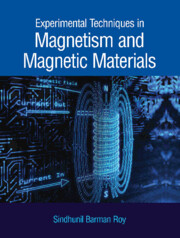Book contents
- Frontmatter
- Dedication
- Contents
- Preface
- I Introduction to Magnetism and Magnetic Materials
- II Basic Phenomenology of Magnetism
- III Experimental Techniques in Magnetism
- Appendix A Magnetic Fields and Their Generation
- Appendix B Units in Magnetism
- Appendix C Demagnetization Field and Demagnetization Factor
- Index
Appendix C - Demagnetization Field and Demagnetization Factor
Published online by Cambridge University Press: 27 October 2022
- Frontmatter
- Dedication
- Contents
- Preface
- I Introduction to Magnetism and Magnetic Materials
- II Basic Phenomenology of Magnetism
- III Experimental Techniques in Magnetism
- Appendix A Magnetic Fields and Their Generation
- Appendix B Units in Magnetism
- Appendix C Demagnetization Field and Demagnetization Factor
- Index
Summary
Phenomenology
Maxwell equations in free space are expressed as:
The electric field E(r,t) and magnetic field B(r,t) are averaged over elementary volume ΔVcentred around the position r. Similarly ρ and j represent electric charge density and current density, respectively. Equation C.1 indicates the absence of magnetic charge and Eqn. C.2 represents Faraday's law of indication in differential form. These two equations do not depend on the sources of an electric field or magnetic field, and they represent the intrinsic properties of the electromagnetic field. Eqns. C.3 and C.4 contain ρ and j, and they describe the coupling between the electromagnetic field and its sources.
Let us now consider a sample of ferromagnetic material through which no macroscopic conduction currents are flowing. A ferromagnet is characterized by the presence of spontaneous magnetization that can produce a magnetic field outside the sample. The microscopic current density jmicro producing such a magnetic field can be associated with the electronic motion inside the atoms and electron spins, or elementary magnetic moments of the ferromagnetic materials. Such microscopic currents present in an elementary volume ΔVcentred about a position r gives rise to an average current [1]:
j M is termed as magnetization current and represents the current density in Maxwell Eqn. C.4 for a ferromagnetic material. This magnetization current jM does not represent any macroscopic flow of charges across the sample. It can rather be crudely associated with current loops confined to atomic distances. This, in turn, implies that the surface integral jM over any generic cross section Sof this ferromagnetic sample must be zero:
This, in turn, tells that jM(r) can be expressed as the curl of another vector M(r):
Now inserting Eqn. C.6 into Eqn. C.7 and with the help of Stoke's theorem, one can convert Eqn. C.6 into a line itegral along some contour completely outside the ferromagnetic sample:
The Eqn. C.8 will be satisfied under all circumstances provided M (r) = 0 outside the sample. This latter condition is true if we take M as the magnetization or magnetic moment density of the ferromagnetic sample. It can be seen from Eqn. C.7 that the magnetic field created by the ferromagnetic sample is identical to the field that would be created by a current distribution jM(r) = ∇×M(r).
- Type
- Chapter
- Information
- Experimental Techniques in Magnetism and Magnetic Materials , pp. 329 - 338Publisher: Cambridge University PressPrint publication year: 2023

